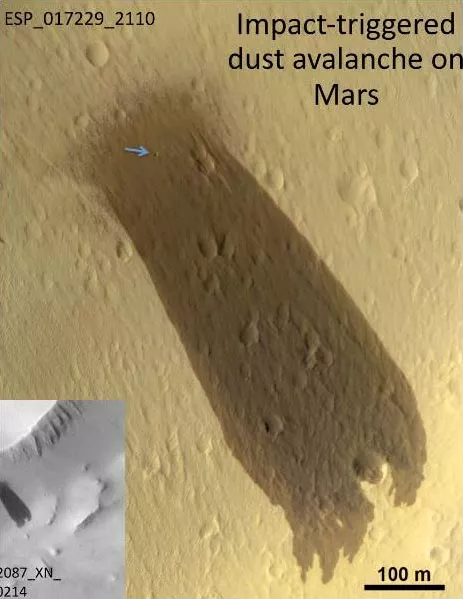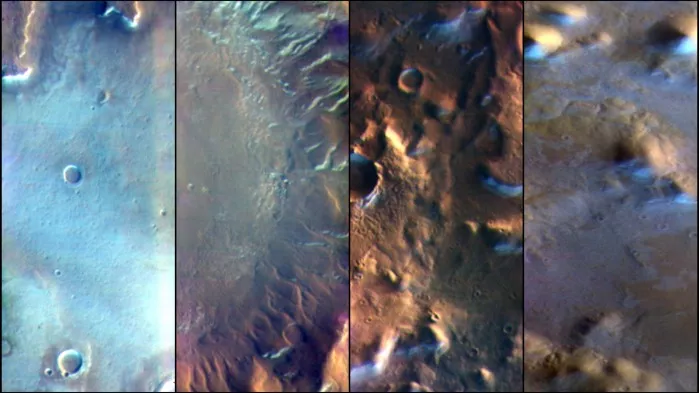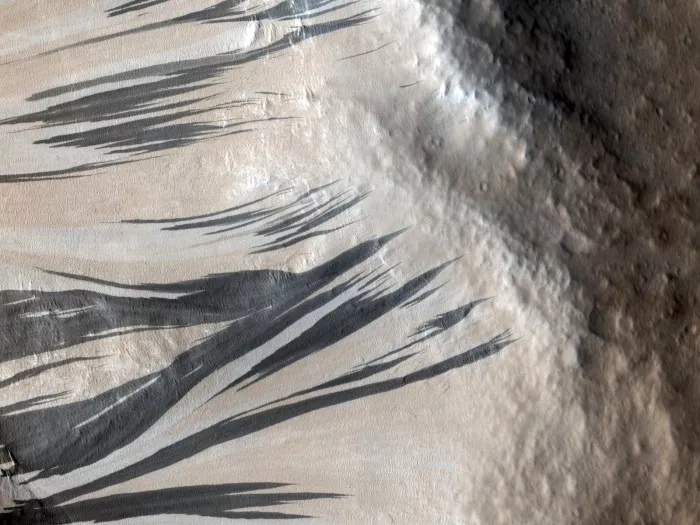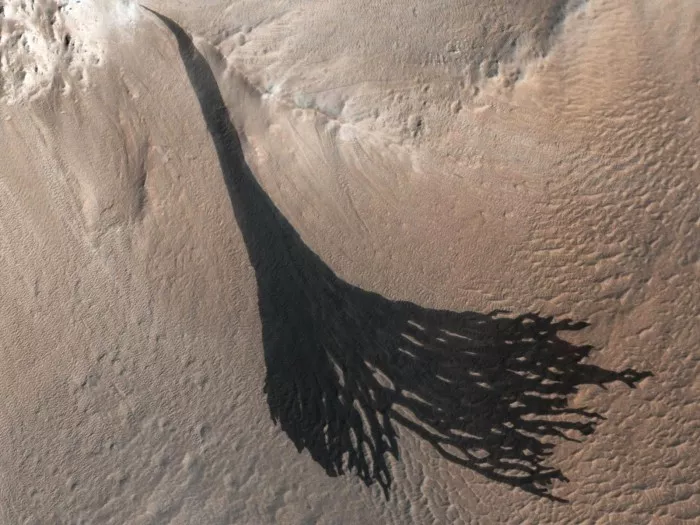For decades, scientists have been observing dark landslides on Mars called slope stripes. The Viking orbiter first saw it in the 1970s, and it has been observed in every orbital mission since then, but the mechanism behind the slope stripes has been hotly debated: are they caused by water activities on the red planet or by some form of drying mechanics**

Dust avalanches caused by large impacts were seen by the HiRISE camera on the Mars Reconnaissance Orbiter.
The main candidate turned out to be "too dry". But scientists on the Mars Odyssey mission have identified another culprit behind the slope stripes: frost formed by carbon dioxide at low temperatures.
Slope stripes usually appear on the walls of craters or on the sides of hills or mountains. Previous studies have determined that the Martian dust and rocks on the slope can be removed by some small things, such as passing dust, or even an impact event in a suitable place, which will lead to an avalanche of dry dust on Mars. Other studies suggest that the sublimation of carbon dioxide frost can shift rocks and cause avalanches, but now the images and data of Odyssey spacecraft have found definite evidence.
Odyssey has been in orbit since 2001, making it the longest running Mars exploration facility. The current orbit of the spacecraft provides a unique view of 7 a.m. local time on Mars. Like on earth, it is the best time to observe frost activities.
Last year, scientists were surprised to see the ghostly blue and white frost illuminated by the rising sun in the images taken by the Odyssey's visible camera. However, Odyssey also carries a thermal emission imaging system (Themis). This kind of heat sensitive camera shows that frost occurs in a wider range, including areas not seen by the visible light camera.

The frost on the surface of Mars, mainly composed of carbon dioxide, appears blue and white in these images taken by the thermal emission imaging system (Themis) camera on NASA's Odyssey orbiter in 2001. The images taken by Themis include both visible light that can be perceived by human eyes and infrared light that is sensitive to heat.
"Odyssey's morning track picture is very spectacular." Said Sylvain piqueux of NASA's Jet Propulsion Laboratory in Southern California, who led the paper. "We can see long shadows at sunrise, which stretch across the surface of Mars."
NASA said that because Mars' atmosphere is very thin (only 1% of earth's density), the sun quickly heated the ice accumulated overnight. Instead of melting, dry ice vaporizes into the atmosphere within minutes.
Lucas Lange, an intern in the jet propulsion laboratory, worked with Pixar. He first noticed that Themis had the low-temperature characteristics of frost in many places that could not be seen on the surface. These temperatures occur in places tens of microns underground - less than the width of "under" human hair.

Slope stripes produced by avalanches of dust from the ahron fossil on Mars. These dark streaks, also known as "ramp streaks", are caused by an avalanche of dust in an area of Mars called Acheron fossae. The HiRISE camera on NASA's Mars Reconnaissance Orbiter captured these stripes on December 3, 2006.
"Our first thought was that the ice might be buried there," Langer said in a press release. "There is a lot of dry ice near the poles of Mars, but we are looking at places closer to the equator of Mars, where it is usually too hot to form dry ice."
Slope streaks or even larger landslides were observed in those same areas. The group explained in their paper.
"At sunrise, the wind driven by sublimation in magma is occasionally strong enough to shift individual dust particles, initiate and maintain dust avalanches on steep hillsides, and form ground features called slope stripes. This model shows that the carbon dioxide frost cycle is an active geomorphic factor at all latitudes, not only at high latitudes or polar latitudes, but may also be a key factor in maintaining a mobile dust reservoir on the ground."
What they saw, the authors said, was what they called "dirty frost" -- dry frost mixed with fine dust particles, which was hidden in visible light, but not in infrared images. They suspect that dirty frost could also explain some dark streaks that could extend 3300 feet (1000 meters) or more along the Martian slope. They know that these stripes are basically caused by dust avalanches, which slowly reshape the slopes of the entire planet and are shown in orbital images.
Scientists say they think these dust avalanches may look like a dust River hugging the ground, releasing a fluffy string of material behind them. As the dust descended in a few hours, it exposed streaks of dark matter below.
Chris Edwards, co-author of the paper at the University of Northern Arizona in Flagstaff, said: "every time we send a mission to Mars, we will find new strange processes. We must understand Mars beyond people's experience on earth."
